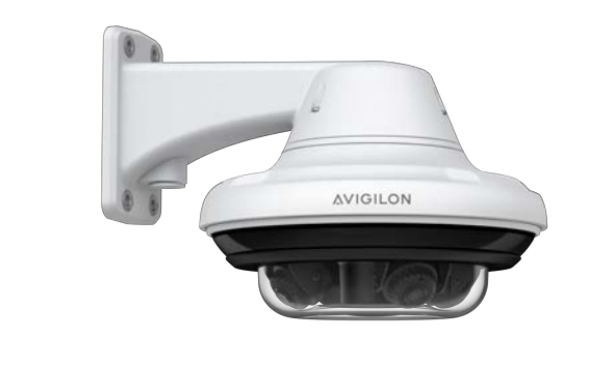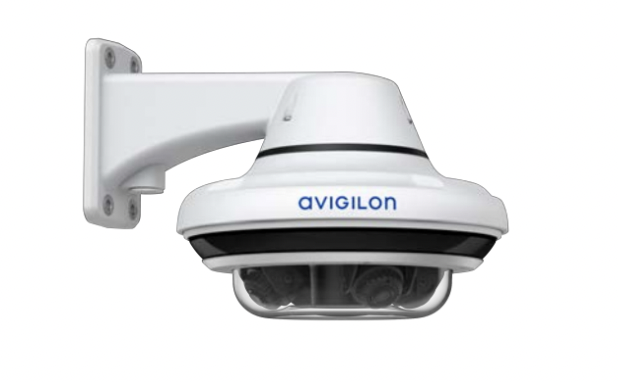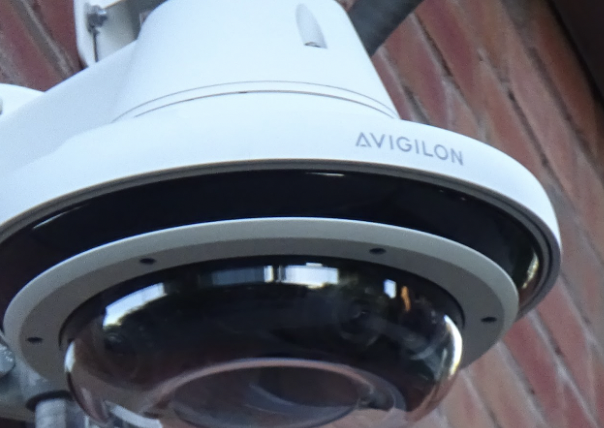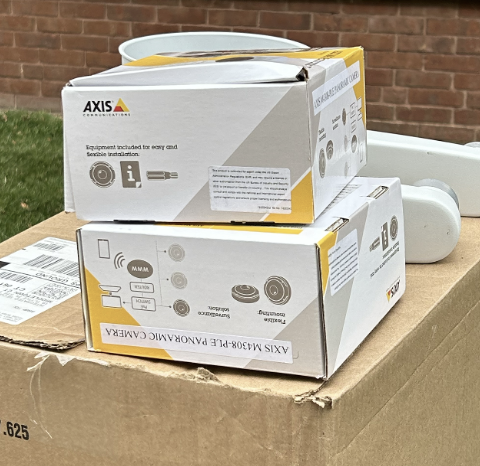
c/o Miles Horner
I saw employees of Integrated Security Group (ISG) install five new cameras around North College on Wednesday, Sept. 18, 2024. Four smaller cameras were installed directly on all four sides of North College, while one large camera was installed outside Boger Hall. When the people installing the cameras were asked what the purpose was, they told multiple students that they were for “the football game,” implying that there was some increased risk of break-in because of football games. One day later, when a campus activist went on NPR to discuss protest monitoring on campus, and specifically allegations of facial recognition in these newly installed cameras, the university made a statement to NPR in response.
“The University has recently installed updated security equipment on campus as part of its year-long assessment of aging infrastructure and in response to recent incidents of vandalism,” the statement read. “While this included new security cameras, the University did not purchase a license for auto-detection or sound recording features.”
Irregardless of the discrepancy between the reasonings behind these new cameras shared with students and what was shared with NPR, the statement that the University did not purchase a “license,” for “auto-detection,” or “sound recording,” is misleading, and, in my opinion, reveals the nature of the administration’s response to last spring’s pro-Palestine protests and encampment. It’s a far cry from what Roth claims to believe: that he wants his campus to be “more political” this year.
Unluckily for the University, students were watching the workers of ISG install these cameras, and a few (me) managed to snap pictures of their packaging.
This is the AXIS M4308-PLE Panoramic Camera, and, even without software, it costs around $1000 per camera. These are the little guys installed around the four sides of North College. For context, the cameras which are used in nearly every other building on campus (besides the Frank Center for Public Affairs (PAC), we’ll get to that later), are the Bosch 3100i camera, which cost around $300/ea. So, you might ask, why is the AXIS M4308-PLE more than three times as expensive as the Bosch camera? That’s because it comes with a built-in DLPU (Deep-Learning Processing Unit), and a built-in microphone. DLPUs enable some of the most complex Video Management Softwares (VMS) which exist on the market, allowing these tiny security cameras to run extremely complex softwares. For context, the Department of Homeland Security has an office in NYC. They use AXIS cameras, and the complex facial recognition softwares that run on those cameras are enabled by the DLPU inside the camera (don’t worry, I’ll get into facial recognition software later). Also, I mentioned a built-in microphone. You may have noticed that in the statement to NPR, the University said they didn’t purchase a sound recording license. Now, that may be true, they may have not purchased a “license” but, again, the cameras come with a built-in microphone, and with built-in voice enhancement & audio capture.
- The Avigilon H5A Alta from the H5A Alta Datasheet c/o Miles Horner
- The Avigilon H5A Unity from the H5A Unity Datasheet c/o Miles Horner
- The Avigilon H5A Alta on Boger Hall c/o Miles Horner
- The Avigilon H5A Unity on the PAC c/o Miles Horner
The Avigilon H5A Unity on the PAC c/o Miles Horner
Clockwise from the top left: 1. The Avigilon H5A Alta from the H5A Alta Datasheet. 2. The Avigilon H5A Unity from the H5A Unity Datasheet. 3. The Avigilon H5A Unity on the PAC. 4. The Avigilon H5A Alta on Boger Hall. c/o Miles Horner
There are many other cameras in the AXIS M43 line of products, including the AXIS M4317-PLR, AXIS M4317-PLVE, and the AXIS M4318-PLR, to name just a few. None of these cameras include a built-in microphone, and they are all at least $100 cheaper than the M4308-PLE. Now, I’d say either the University intentionally bought the more expensive camera because it had audio detection, or they simply didn’t realize they were buying the one with audio detection.
I encourage you to look at these cameras for yourself! You can see the AXIS logo on them, and you can actually see the microphones! I also encourage you to think about what it means to have an educational institution intentionally mislead the press. That’s extremely worrying, and doubly so when you realize the location of these cameras: outside North College. When Director of Public Safety Scott Rohde was reached for comment, he indicated that he couldn’t recall any break-ins that occurred at North College during his entire tenure here, since 2014. The only reason I can think of why the administration has decided to place these cameras outside of North College is to deter another encampment. Break-ins and intruders in West College, Low Rise, Exley Science Center, and Bennet? Who cares! Cars being vandalized in the V lot? Who gives a shit! Students simply bothering the administration, asking that they make a commitment to decry & stop investing in literal genocide? Now that’s important! Better buy as much fancy security equipment as possible.
I haven’t even gotten into the big boy, the H5A Multisensor camera, from Avigilon. The reason we know what camera this is because it’s the only camera that looks like this on the Avigilon website. There are two models of the H5A Multisensor Camera and, from what we’ve seen, Wesleyan has actually purchased both! One is on the PAC, and the other is on Boger. The one on the PAC has been around since the PAC was completed last spring, and the one on Boger was installed on Sept. 18, just like the Axis ones.
There are two key differences between the Unity and Alta models. One, obviously, is the visuals: the Unity has the Avigilon logo in blue and lowercase, and the Alta has it in gray and uppercase. The other difference is how the two process their data. The Unity model is on-premise, meaning it requires the operator to purchase an additional VMS license to make sure it runs properly. The Alta, however, is cloud-native, meaning that it is not necessary to purchase another license, because the software is built into the camera. This is why the Alta is connected directly to an Aruba Networks router (who supplies our Wi-Fi on campus), while the Unity is not. Again, I encourage you to walk around campus yourself! You won’t find a router with a cable like this, and you definitely won’t find another security camera on campus connected to a router. I guess they’re not lying when they say they didn’t purchase a “license” for “auto-detection,” but since the software is built into the camera, they don’t need to.
So, you might be wondering, what exactly is in this software that’s so important that it needs to be directly connected to the Wi-Fi router? Could it be…facial recognition? That’s right! It is!
It says it right on the website: detected attributes: face. Not only that, but these cameras can also detect the color of your clothing, meaning that even if your face is covered, they can still aim to track you all around campus. According to the Alta Aware datasheet, it also includes face search, appearance search, crowd counting, audio analytics, and real-time alerts. Avigilon claims that their “appearance search” technology, which comes pre-installed in Avigilon Alta, isn’t facial recognition, since it only observes people’s “facial characteristics,” and doesn’t link them to a specific identity.
“The Avigilon Alta Aware software includes powerful search tools to enable you to investigate and find evidence events,” the Alta documentation reads. “With Appearance search, you select the key parameters of what you are searching for…. You can use Search to look for faces, so that you can carry out a similarity search across multiple camera views…. Additionally, if you have an image of the person, the person’s face, or the vehicle you are looking for, you can use the image as the basis for your search.”
You are all free to decide if you think that’s facial recognition or not. To me, using an AI algorithm to search for a face, according to a face uploaded to the system, sounds like facial recognition. With appearance search, it is far easier for the person operating the VMS to track someone if they already have a picture of them. For people the system doesn’t recognize, it takes time for it to develop “appearances” that it can then track. In case you forgot, Wesleyan already has a database of every person’s face: your student/faculty/staff ID. This technology was purchased by the administration to monitor you—the students, faculty, and staff of this campus—not to protect you.
It’s also worth noting that the Alta camera, the one installed outside Boger, is advertised as the more expensive option compared to the Unity, the key difference being that the Alta has access to invasive technologies like facial recognition without needing to purchase a license. The Alta, and Unity, for that matter, have access to much more complex facial recognition softwares that give the operators real-time alerts when identified individuals enter certain areas.
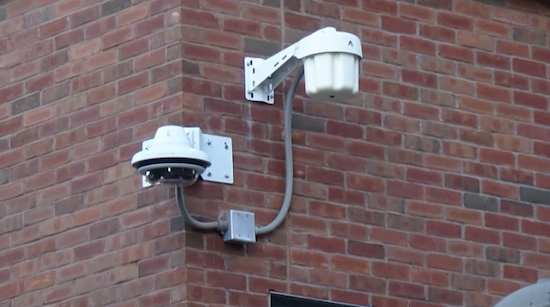
c/o Miles Horner
At a recent faculty meeting, the administration denied that these cameras have any form of facial recognition technology (lying), and justified this purchase because of the LPR (license plate recognition) capacity. License plate recognition? Around North College? So you can keep track of the food truck? Why the security upgrade now? It is clear to me that these cameras exist to deter free speech, and give the administration a shield from criticism, specifically around divestment. This is leagues away from the “energetic community of students, faculty, and staff who think critically and creatively and who value independence of mind and generosity of spirit” that Wesleyan claims it wants to foster. In fact, this is an abhorrently closed-minded choice. To—in the face of genocide, colonialism, expansionism, violence, warmongering—respond to campus protests that ask that we make a stand against that evil by purchasing these cameras, from these companies specifically, is unacceptable.
Axis Communications is a frequent partner of Israeli software firm Briefcam, which provides video management software to law enforcement, occupation, and police forces globally. From Riyadh to Xinjiang to Palestine, Briefcam facial recognition software and Axis cameras are contracted to enable oppression and facilitate the occupation of peoples worldwide. They profit off it. The Israeli police have contracted with Briefcam. In 2023, Axis inaugurated Ariel Harush and Roy Hodir of OTORIO, an Israeli cybersecurity firm founded by the Israeli Defense Forces’ experts, into their “Security Hall of Fame.” Ariel Harush was formerly a cybersecurity specialist for the Israeli Military Intelligence.
Israel’s “Mabat 2000” project, a big-brother system in Jerusalem, uses cameras from a company named VideoTec. It uses thousands of cameras and an AI algorithm that uses every observed word, image, and interaction to construct personal identities of every Palestinian. Who owns VideoTec, you ask? Why, it’s Motorola Solutions, one of the leading law enforcement services providers in the world! They also happen to own a funny company called Avigilon. Both companies are deeply complicit in this genocide; they have long facilitated and actively profited off of the Israeli occupation of Gaza and Palestine.
Because of those DLPUs I was talking about earlier, all of the cameras that Wesleyan purchased outside North College could have Briefcam software, or a suite of other facial recognition technologies. Unless the University releases their purchase records, which I encourage them to do, we won’t know whether or not military-grade software is being used on students. By choosing to militarize our campus, to actively contribute to the occupation, instead of addressing the real wants of not only the campus but also the world, this administration has spit in the face of decency. This is a disgusting response to requests to make a stand against genocide, a decision that I hope haunts the members of this administration in the coming years.
Miles Horner is in the class of 2026 and can be reached at mhorner@wesleyan.edu.
